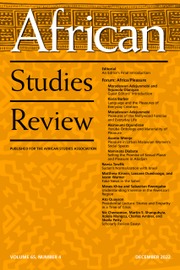Countering violent extremism (CVE) has become an increasingly prominent approach to combating the threats of extremism, especially in the years following 9/11. Unlike interventions that rely on military force or “hard power,” CVE employs “soft power” strategies that include education and deradicalization programs, as well as a focus on counternarratives and development. CVE tools are often anchored at the community level, as communities are crucially positioned to respond to threats of radicalisation and recruitment. While CVE aims to build “community resilience” to violent extremism (VE), scholarship also highlights how it can inadvertently contribute to the marginalization and securitization of vulnerable communities. John Mwangi Githigaro contributes to this research field by exploring various stakeholders’ perspectives on the effectiveness of CVE measures in Kenya. The book poses the central question: How do stakeholders present the threats of extremism and the effectiveness of countermeasures in Kenya? (1). Githigaro draws on extensive ethnographic research conducted in Nairobi and Mombasa, specifically in three hotspots for Al-Shabaab recruitment and radicalization.
The book makes a significant contribution by problematizing CVE interventions and the challenges that render these less effective (2), which stem, in part, from poor trust in the state’s security apparatus. As the author notes, hard power interventions in Kenya have been criticized for leading to religious and ethnic profiling and human rights abuses, including arbitrary arrests and extrajudicial killings (16). The arguments are refined across seven sections. In the introduction, the author engages with the broader literature on counterterrorism and CVE, radicalization, and community resilience, highlighting the strengths and drawbacks of various community engagements in Kenya and other VE-affected countries. Chapter One traces Kenya’s experiences with terrorism before and after 9/11, focusing on interventions and policy shifts towards CVE, as well as the role of external Western donors and Global War on Terror discourses. The threat of Al-Shabaab, responsible for several terrorist attacks in Kenya since the early 2000s, is well documented in this chapter.
Chapters Two to Four leverage the author’s rich fieldwork data collected over several years in Nairobi (specifically in Eastleigh and Majengo) and Mombasa (specifically in Likoni). These chapters focus on the perceptions of various stakeholders, including security officials, religious leaders, civil society actors, academics, and community members. Here, the author highlights numerous community-level interventions, such as conversation spaces, youth economic empowerment, and community policing (55). The book’s findings illustrate several dilemmas in Kenya’s CVE efforts. These are explored in greater depth in Chapter Five, where Githigaro expands on trust deficits between communities and security agencies, particularly the police; the securitization of ethnic (Somali) and religious (Muslim) identities; and the ownership of CVE interventions. Community members often feel stigmatized for collaborating with security agencies. Although there is substantial potential for information-sharing and collective problem-solving in the CVE domain, the author argues that these challenges hamper the reach and effectiveness of community-based interventions (103). Githigaro concludes that, while Kenya’s approaches have shifted from state-centric, hard power approaches to soft power interventions, continuous trust-building is necessary to address gaps and emergent challenges (112).
While the book presents ample and illustrative findings, the dilemma of local ownership of CVE approaches remains underexplored. As the author describes, countermeasures are not without their flaws and challenges, and community members seem to exhibit reluctance or outright scepticism towards many of these interventions. The reader is therefore left wondering how context-specific and “bottom-up” these efforts truly are, and whether they sustain community resilience to VE. Are communities able to exercise their agency, influencing and directing CVE tools such as community policing, or are they merely local enactors of state-led interventions? The use of drama and arts in Likoni suggests that communities may have preferences and indeed craft responses that resonate better with their members (85). Lastly, the author shows how some community members preferred to relay sensitive information to national government structures, such as county commissioners, rather than the police (96). What role do peace committees then play? These committees are structures close to the national government administration officers but remain, at least in theory, localized and representative. The author mentions that they are strategies to prevent radicalization (111), but their impact and how the community perceives them is not addressed in this book. This focus could offer potential avenues for further research.
Countering Violent Extremism in Kenya is an important book for academics and practitioners with an interest in VE and political violence in Kenya and East Africa. It elucidates current debates and dilemmas surrounding localization and state-community relations in “bottom-up” interventions. Importantly, it brings forward the voices of community members themselves, showcasing their perspectives, challenges, and needs in CVE interventions.


